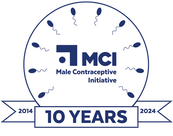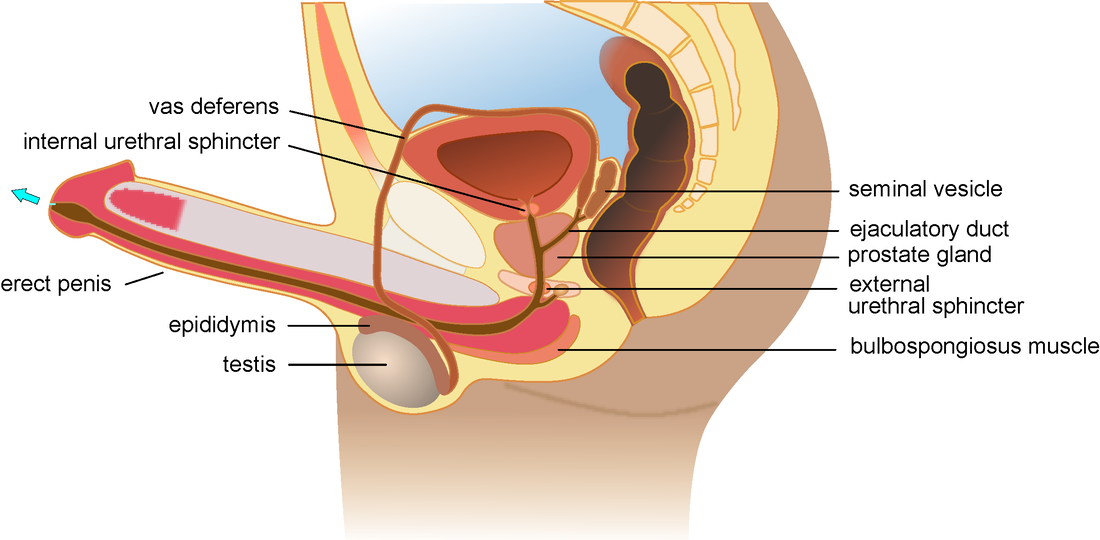|
(Image courtesy of Wumingbai) Ejaculation is the discharge of semen from the male reproductive tract as a result of an orgasm. It is the final stage and natural objective of male sexual stimulation, and an essential component of natural conception. When a man has achieved a sufficient level of stimulation, the orgasm and ejaculation begins. At this point, semen containing sperm is produced and is subsequently ejected through the urethra with the aid of muscular contractions. Most men experience what is called a ‘refractory period’ immediately following orgasm and ejaculation. During this time, they are unable to achieve another erection, with a longer period before they are capable of ejaculating again. It is common for a male to feel a deep sense of relaxation, particularly in the groin and thighs, during the refractory period, and its duration varies considerably among individuals. Typically younger males recover faster than older men, though this is not universally the case. In rare cases, ejaculation occurs because of disease in the prostate. More commonly, it may also occur spontaneously during sleep (which is commonly referred to as a “nocturnal emission” or a "wet dream"). Anejaculation is the term for the condition of being unable to ejaculate. Ejaculation is intended to be and is usually pleasurable for men. However, when it is painful or displeasurable it is referred to as ‘dysejaculation’. Retrograde ejaculation is the condition where semen travels backwards into the bladder rather than out the urethra. This is sometimes referred to as a ‘dry orgasm’ as little or no semen is ejaculated when this occurs. Though sexual climax still happens during this type of ejaculation and the act is not harmful when it occurs, it can lead to infertility in men. Premature ejaculation is when ejaculation occurs before it is intended. Conversely, the inability to ejaculate in a timely manner after sexual stimulation is called ‘delayed ejaculation’ or ‘anorgasmia’. Nuts & Bolts: Ejaculation To learn more about, please visit our series of posts about male reproduction and contraception: Key terms: Anejaculation - the condition of being unable to ejaculate. Anorgasmia - the medical term for regular difficulty reaching orgasm after ample sexual stimulation. Orgasm - a climax of sexual excitement, characterized by feelings of pleasure centered in the genitals and (in men) experienced as an accompaniment to ejaculation. Semen - the male reproductive fluid, containing spermatozoa in suspension. Urethra - the duct by which urine is conveyed out of the body from the bladder, and which in male vertebrates also conveys semen. For additional terminology related to male contraception and the male reproductive system, please visit our glossary: Sources/References: Koeppen, Bruce M.; Stanton, Bruce A. (2008). Berne & Levy Physiology. Philadelphia, PA: Elsevier/Mosby. ISBN 978-0-323-04582-7. Boron, Walter F.; Boulpaep, Emile L. (2005). Medical Physiology: A Cellular and Molecular Approach. Philadelphia, PA: Elsevier/Saunders. ISBN 978-1-4160-2328-9. Marieb, Elaine (2013). Anatomy & physiology. Benjamin-Cummings. p. 895. ISBN 978-0-321-88760-3. Masters, W.H.; Johnson, V.E. (1970). Human Sexual Response. Boston: Little, Brown and Company. Dunn, M.E.; Trost, J.E. (1989). "Male Multiple Orgasms: A Descriptive Study". Archives of Sexual Behavior. 18 (5): 377–387. doi:10.1007/BF01541970. PMID 2818169. S2CID 13647953. Wylie KR, ed. (2015). ABC of Sexual Health. John Wiley & Sons. p. 75. ISBN 978-1-118-66556-5. For additional publications related to male contraception and the male reproductive system, please visit our publications page:
Comments are closed.
|
Categories
All
Archives
June 2024
|
|
|
Donate to Male Contraceptive InitiativeYour generous donation makes a difference!
|
© Male Contraceptive Initiative. All rights reserved.


 RSS Feed
RSS Feed
